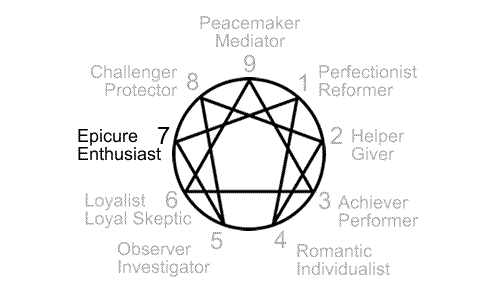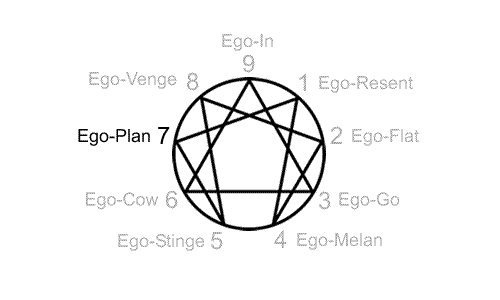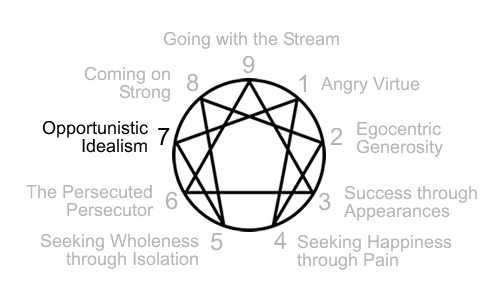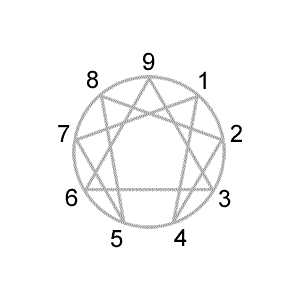Enneagram Type 7: Enthusiasm through Mental Possibility
The core focus of Enneagram type 7

Follow your bliss and the universe will open doors where there were only walls.
- Joseph Campbell
Early in life we develop an initial belief about ourselves and a compensation for that self-belief.
-
Type 7 Initial Self-Belief: “I am not satisfied as I am.”
Type 7 Compensation: "I must stay open to exciting possibilities that may become available in life and avoid limitations on my pursuits."
Over time this gets generalized beyond the self into a core focus that also shapes how we perceive and interact with the world at large.
-
Type 7 Core Focus: Enthusiasm comes from possibilities that lead to something interesting, exciting, or satisfying. This requires that I anticipate whether a path might lead to something positive or negative. The positives are pursued while the negatives are avoided, reframed, or escaped from.
Personality characteristics that might arise from the type 7 core focus include:
- Likes to keep options open for fear of missing out in life
- Escapes pain and boredom by quickly moving on to something else
- Avoids commitments/obligations that feel limiting and restrictive
- Equalizes relationships with authority to avoid being limited by them
- Attempts to lighten up situations when they become too serious
- Mind quickly jumps between possibilities when excited about an idea
- Lives in anticpation of fun and exciting future possibilities
- Difficulties following through to completion on projects
- Skates on the surface of feelings for fear of getting stuck in them
Enneagram author descriptions of type 7

Below are Enneagram type 7 description samplings from some popular or well-known Enneagram authors. Click on the sources after the descriptions to further explore these interpretations.
-
The Enthusiast, The Busy, Fun-Loving Type: Spontaneous, Versatile, Acquisitive, and Scattered
Basic Fear: Of being deprived and trapped in pain1
Basic Desire: To be happy, satisfied, to find fulfillment1
-
How Sevens Pay Attention: From an outsider’s point of view, a Seven can look like a dilettante, with many scattered interests: several projects moving at the same time, three or four half-finished books on the floor.2
Basic Proposition: You can avoid pain and frustration by inventing options, opportunities and adventures.2
Strengths: Adventurous, playful, imaginative, energetic, optimistic, quick-thinking2
Challenges: Self-absorbed, dispersed, uncommitted, impatient, unrealistic2
-
Energy goes into: Enjoying and experiencing life to its fullest. Keeping options open and life upbeat. Using my active imagination. Being liked by being charming and disarming. Maintaining a privileged position.3
-
The Enthusiast: Fun, spontaneous and adventurous, they are motivated by a need to be happy, to plan stimulating experiences and to avoid pain.4
-
Adventurers are energetic, lively, and optimistic. They want to contribute to the world.5
-
Focus of Attention: Sevens avoid unpleasant feelings by focusing on what feels pleasant and by keeping the mood upbeat to the point of reframing negatives into positives. A fear of being trapped in discomfort fuels quick thinking, creative problem-solving, and a focus on positive future possibilities.6
Sources
1Book: The Wisdom of the Enneagram; Website: The Enneagram Institute
2Book: The Enneagram; Website: The Narrative Enneagram
3Book: The Essential Enneagram; Website: Dr. David Daniels
4Book: The Road Back to You
5Book: The Enneagram Made Easy
6Book: The Complete Enneagram; Website: Chestnut Paes Enneagram Academy
Type 7 Ego: Ego-Plan

The roots of the Enneagram types come from Oscar Ichazo's ego types. The ego types identified how a person was fixated in ego and the remedy for finding freedom from that.
Below are descriptions of Oscar Ichazo's ego type 7 fixation, trap, holy idea, passion, and virtue reinterpreted for today's Enneagram personality types.
Type 7 Fixation and Trap
Fixation: Planning is about looking forward to many exciting possibilities and a way to fit them all into one's life.
Trap: Idealism that is enthused about what's possible but moves on to what's next when the enthusiasm wanes.
The fixation of planning points to the mental preoccupation of the type 7 ego. The trap of idealism keeps an individual stuck in the fixation.
Type 7 Holy Idea
Holy Idea: Holy Work is following through in the present on what seems uncomfortable or difficult but leads to a deeper satisfaction and joy.
The fixation of planning and trap of idealism keep an individual stuck in the type 7 fixation. The way out of that fixation is through holy work.
Type 7 Passion
Passion: Gluttony of the mind is the pull felt toward interesting possibilities. "Why get mired in boredom or discomfort when pleasurable alternatives are available?"
The passion of gluttony is the emotional energy that serves the fixation of planning and trap of idealism.
Type 7 Virtue
Virtue: Sobriety appears when you see endeavors through to the end instead of moving on to something easier and more interesting than what's at hand.
The virtue of sobriety is what appears when the passion of gluttony subsides.
Personality traits of Enneagram type 7

A psychiatrist named Claudio Naranjo evolved Oscar Ichazo's ego-types into the Enneagram personality types as we use them today. Naranjo largely based the types on Ichazo's passions.
Naranjo outlined the following trait structure for type 7 (Ennea-type VII) in his books Ennea-type Structures and Character and Neurosis.
- Opportunistic Idealism - Gluttony, Fraudulence, and Narcissism
- Gluttony
- Hedonistic Permissiveness
- Rebelliousness
- Lack of Discipline
- Imaginary Wish Fulfillment
- Seductive Pleasingness
- Narcissism
- Persuasiveness
- Fraudulence
Enneagram type 7 examples
While reading about the Enneagram types can be useful in understanding them, you eventually have to bring the types to life by seeing the many different ways they get expressed in life.
While the ideal is to be able to interact directly with people of each type, an alternative is to observe them from a distance. There are a number of ways to do this using videos. Many of these videos can be found on the Internet if you know what to look for (YouTube in particular).
- Type 7 Interviews and Self-Revelations
One method used to bring the types to life when teaching the Enneagram types involves interviewing people of a given type about how that type plays out in their life. This may be done through panels and one-on-one interviews.
Self-revelatory videos can also be useful where a person simply describes their type to a camera without the prompting of an interviewer.
Note that sometimes a person in a video may have been mistyped and may not offer an accurate representation of type when that happens.
- Type 7 Celebrities or Famous People
Once their Enneagram type is known, celebrities or famous people can also offer interesting examples of and insights into Enneagram type as revealed through interviews, lectures, writings, and the person's work.
However, it's not like the Enneagram panels, interviews, and self-revelations where people are specifically describing how they experience Enneagram type in their lives. It's more a matter of looking for glimpses into how Enneagram type is operating in the person.
It can be difficult to type someone at a distance. Look for a consensus of opinion on a person's type from multiple sources and hold it loosely. Celebrities and famous people are often typed differently by different Enneagram authors, teachers, and enthusiasts.
- Type 7 Fictional Characters
It needs to be made clear that fictional characters are not real people, even when they are based on real people. There can be a temptation to assign Enneagram type to every character in a story, but many characters don't have that kind of consistency or depth.
Not only might there be a number of different people, usually of different types, influencing the creation or portrayal of a character but often the character is nothing more than a vehicle for telling the story and moving it along.
While once in a while a character appears that you can attribute an Enneagram type to, generally it's more accurate to look at specific scenes as examples of a type rather than the character as a whole.
Tom Condon wrote a book called The Enneagram Movie & Video Guide that you may find useful for seeing type in fictional characters.
- Type 7 Songs and Lyrics
Although they do exist, there are few song lyrics that can be attributed to one particular Enneagram type. Most songs have both lyrical and musical elements that can be attributed to a number of different Enneagram types.
Songs are extremely subjective. There are many songs that listeners, and even performers, interpret in a very different way than the song writer intended. A number of songs also emphasize the sounds of words rather than their meaning.
As such, different people hearing the same song often will experience it as representing different Enneagram types.
Enneagram type 7 variations
There are a number of variations or flavors of type 7 that help explain why two people of the same type seem different. Click below for more info about variations of type 7.
Type 7 mistypes
Some people correctly identify their Enneagram type on their first try. For most other people determining type can take some time.
If you feel that you may have wrongly typed yourself as type 7 and have one or more alternative candidate types in mind then click on a link below to take a quick Enneagram test comparing type 7 to another type that may instead be your type.
Enneagram Tests to Help Determine Type

The Enneagram personality types consist of nine basic types. One of the types will be more dominant than the others. This dominant type is said to be "your Enneagram type".
Although there are nine basic Enneagram types, there are also many variations within each type as defined by such concepts as wings, centers, and instincts.
You can explore these variations using the type preference test below or one of the many other tests available on this website.
-
Enneagram Type Preference Test
This test produces a scored list of all nine types.
Questions are forced-choice, similar to the method used by the Riso-Hudson Enneagram Type Indictor (RHETI).
Use to determine type, wings, gut/heart/head types, and tri-center. -
Enneagram Type Comparison Test
This test compares any two types. The preferred type will have the higher score.
Use when you've narrowed your type down to two or three possibilities you'd like to compare.
Click here for the Complete Guide to the Enneagram.
This free guide explains- the nine Enneagram personality types
- the many type variations within type
- where the types came from (origins and history)
- how the types use the Enneagram symbol
Click here for Enneagram tests.
These free tests help you find your- primary type
- candidate types
- preferred wing
- intinctual subtype
- instinctual variant stacking
- center types (gut, heart, and head)
- tri-center with wings